The Best Group Treks in Nepal
Nepal's towering peaks and legendary trails call to adventurers worldwide, and we've discovered that experiencing these mountains with a group creates memories that last a lifetime. The best group treks in Nepal offer something solo adventures simply can't match – shared moments of triumph, built-in safety, and instant friendships forged at altitude.
At Luxury Holiday Nepal, we've guided countless trekkers through Nepal's most spectacular routes, and we know that group trekking appeals to adventure seekers who want the mountains without the isolation, first-time Himalayan visitors who value expert guidance, and experienced hikers looking to explore new trails with like-minded companions.
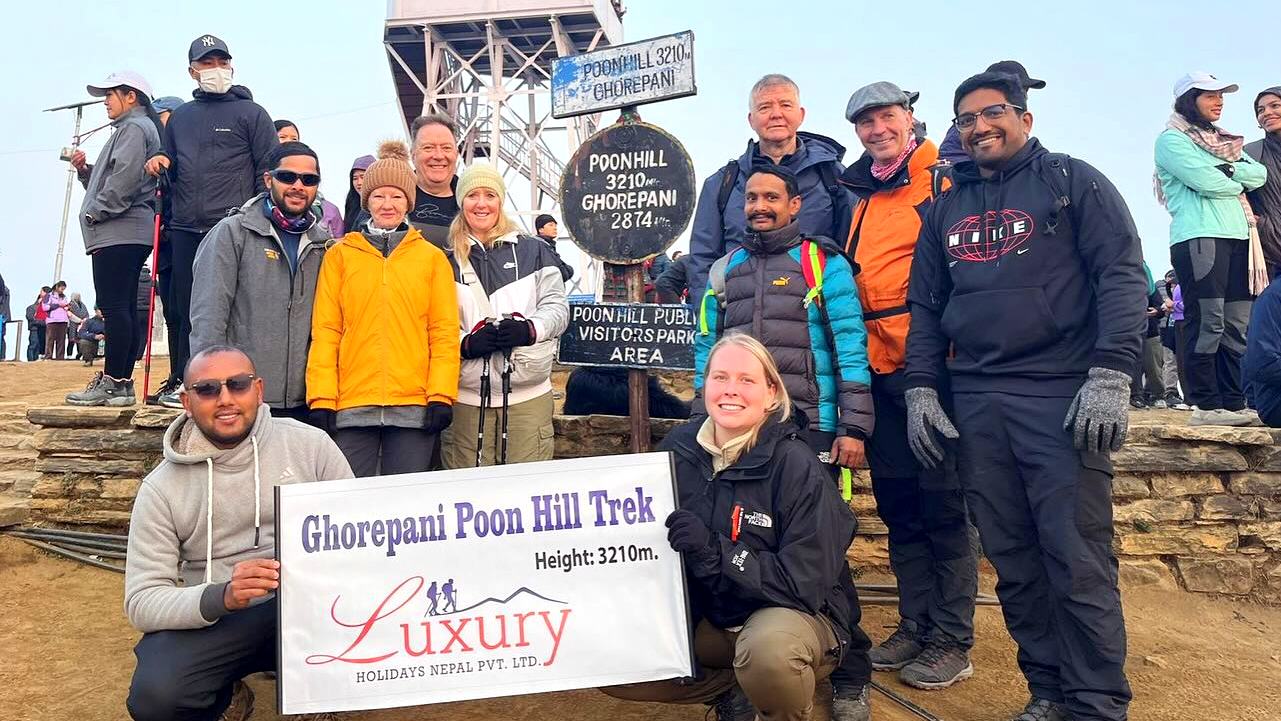
In this comprehensive guide, we'll explore why group treks consistently outshine solo adventures in Nepal's challenging terrain, where safety and camaraderie make all the difference. We'll also reveal our top-rated group trek destinations in the Himalayas, from the iconic Everest Base Camp to hidden gems like Upper Mustang, complete with what makes each route special for group experiences. Finally, we'll share our essential preparation tips for group trekking success, covering everything from fitness requirements to gear recommendations that ensure your Himalayan adventure exceeds expectations.
Why Choose Group Treks Over Solo Adventures in Nepal
Cost-effective sharing of guides, permits, and accommodation
When we join group treks in Nepal, we immediately notice how much we save compared to going solo. The biggest expense - hiring a professional guide - gets split among all group members, often cutting our individual costs by 70-80%. We share the same permits required for restricted areas like Everest Base Camp or Annapurna Circuit, which can cost upwards of $30-50 per person but feel much lighter when divided.
Our accommodation expenses drop significantly, too. We book teahouses and lodges as a group, securing better rates and often getting upgraded rooms. Food costs become more manageable when we order group meals, and we can try more diverse local dishes since we're sharing everything. Transportation to trailheads gets cheaper when we fill entire jeeps or buses together.
We've found that group bookings for domestic flights to mountain regions like Lukla often come with discounts. Even equipment rentals become affordable when outfitters offer group packages for sleeping bags, trekking poles, and other gear we might need.
Enhanced safety through collective decision-making and support
Group trekking transforms safety from our biggest worry into our strongest advantage. When we face challenging weather conditions or difficult terrain, we have multiple perspectives helping us make smart decisions. If one of us feels unwell or shows signs of altitude sickness, others can quickly recognize symptoms and provide immediate support.
We create natural buddy systems where we constantly check on each other's well-being. During river crossings, steep descents, or icy morning starts, we help each other navigate tricky sections. Our group becomes a mobile support network - if someone's pack breaks, gets lost, or faces equipment failure, we share resources and solutions immediately.
Medical emergencies become less frightening when we travel together. We carry shared first-aid supplies, and there's always someone who can assist with basic medical care or help coordinate evacuations if needed. We've seen groups where retired doctors, nurses, or wilderness first-aid certified members provide incredible peace of mind for everyone.
Communication with rescue services improves dramatically in groups. We have multiple phone batteries, satellite communication devices, and people who can stay behind while others go for help. Our collective experience often includes someone who's trekked the route before or speaks local languages.
Cultural exchange and lasting friendships with fellow trekkers
Every group trek we join becomes a melting pot of cultures, backgrounds, and stories. We meet people from different continents who share our passion for mountains and adventure. Around evening campfires or in cozy teahouse common rooms, we exchange travel tales, career experiences, and life philosophies that broaden our perspectives dramatically.
We learn new languages from our fellow trekkers - picking up German hiking songs, Italian expressions, or Japanese greetings that make our journey richer. Food sharing introduces us to snacks and meals from different countries. We often discover new music, books, and travel destinations through our group conversations.
These connections extend far beyond our trek dates. We maintain friendships through social media, visit each other in home countries, and often plan future adventures together. Many of us have attended weddings, career celebrations, and family events of people we met on Himalayan trails.
The cultural exchange with local communities becomes more meaningful in groups too. We engage with Sherpa families, Gurung villages, and Tibetan Buddhist monasteries as a diverse international group, creating memorable interactions for both visitors and hosts.
Professional leadership ensuring smooth logistics and navigation
Our experienced trek leaders handle the complex logistics that would overwhelm us as solo trekkers. They manage permits, accommodation bookings, meal arrangements, and transportation coordination while we focus on enjoying our adventure. These professionals know every teahouse owner, understand local customs, and have established relationships that smooth our entire journey.
Navigation becomes foolproof with professional guides who know every trail marker, shortcut, and alternative route. They read weather patterns, assess trail conditions, and make real-time adjustments to our itinerary when needed. We never worry about getting lost or taking wrong turns because our leaders have walked these paths hundreds of times.
Our guides serve as cultural bridges, translating conversations with locals, explaining religious sites, and sharing historical context that transforms simple walks into educational experiences. They know which teahouses serve the best dal bhat, where to find the cleanest bathrooms, and how to negotiate fair prices for additional services.
Emergency protocols become professional-grade with experienced leaders. They carry satellite phones, know evacuation procedures, and have direct contacts with helicopter rescue services. We benefit from their medical training, altitude sickness recognition, and crisis management skills that could save our lives in serious situations.
Top-Rated Group Trek Destinations in the Himalayas
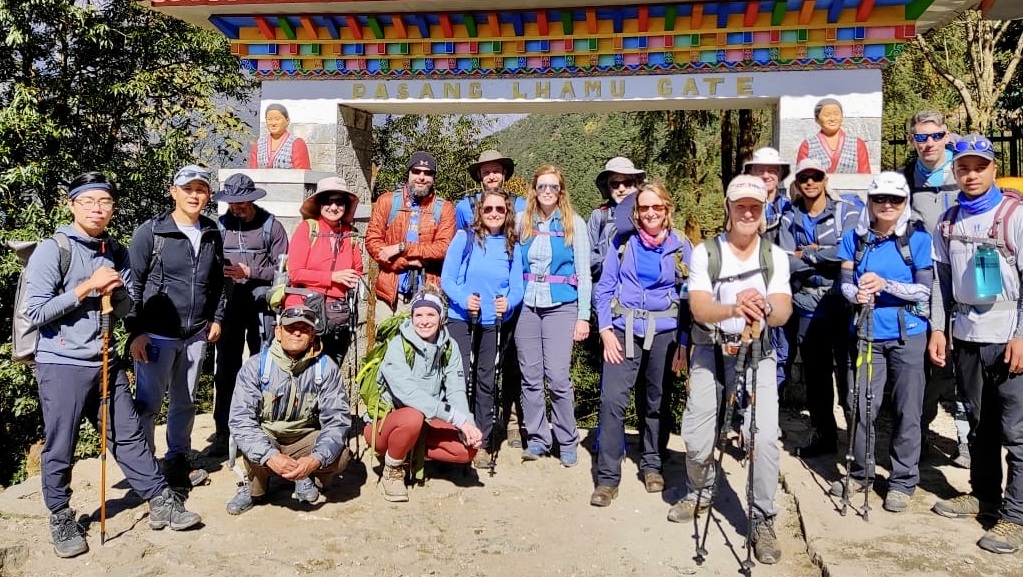
Everest Base Camp - The ultimate bucket list adventure
We've guided thousands of trekkers to the foot of the world's highest peak, and we can confidently say that Everest Base Camp remains the crown jewel of Himalayan adventures. This legendary 12-14 day journey takes our groups through the heart of Sherpa country, passing through vibrant rhododendron forests, crossing dramatic suspension bridges, and ascending through ancient monasteries that have blessed countless expeditions.
Our groups experience the electric atmosphere of Namche Bazaar, the bustling mountain trading post where we spend crucial acclimatization days. We watch our trekkers' excitement build as they catch their first glimpse of Everest from Kala Patthar, standing at 5,545 meters for sunrise views that will forever be etched in memory. The camaraderie that develops during those challenging final days to base camp at 5,364 meters creates bonds that last well beyond the trek.
We typically run groups of 8-12 people, allowing for personalized attention while maintaining the group dynamic that makes shared achievements so special. Our experienced Sherpa guides share stories passed down through generations, adding cultural depth to this physical challenge. The sense of accomplishment when our groups reach base camp, surrounded by towering seracs and the constant rumble of the Khumbu Icefall, represents the pinnacle of group trekking experiences in Nepal.
Here are some of the best group treks in Everest base camp:-
Annapurna Circuit - Classic mountain scenery and diverse landscapes
We consider the Annapurna Circuit the perfect introduction to high-altitude group trekking, offering our adventurers an incredible variety of landscapes within a single journey. This classic 15-17 day trek showcases everything that makes Nepal special - from subtropical forests alive with monkeys and exotic birds to the stark, windswept terrain above the Thorong La Pass at 5,416 meters.
Our groups start in the lush Marsyangdi Valley, where we trek through terraced rice fields and traditional Gurung villages. We love seeing our trekkers' amazement as the scenery transforms daily, progressing from tropical greenery to alpine meadows dotted with blue sheep, and finally to the dramatic desert-like landscape of Mustang. The diversity keeps everyone engaged, as there's something new around every corner.
We time our crossings of Thorong La Pass carefully, ensuring our groups are properly acclimatized and weather conditions are favorable. The descent into the sacred Muktinath temple complex always brings a mix of relief and spiritual reflection to our trekkers. We then lead groups through the world's deepest gorge, the Kali Gandaki, before concluding in the picturesque lakeside town of Pokhara. Our groups consistently rate this trek highly for its perfect balance of challenge, culture, and natural beauty.
Here are some of the best group treks in Annapurna region:-
Langtang Valley - Perfect blend of culture and pristine nature
We've developed a special connection to the Langtang region, particularly after supporting the local communities' remarkable recovery following the 2015 earthquake. This 7-10 day trek offers our groups an intimate mountain experience without the crowds found on more popular routes. We call it our "hidden gem" because it delivers spectacular mountain views, rich Tamang culture, and pristine forests all within easy reach of Kathmandu.
Our groups trek through dense rhododendron and bamboo forests where we regularly spot red pandas, Himalayan black bears, and over 250 bird species. We love guiding our trekkers through traditional Tamang villages where the Tibetan-influenced culture remains beautifully preserved. The local hospitality in places like Langtang village and Kyanjin Gompa consistently moves our groups, as families welcome us with warm smiles and butter tea despite their own modest circumstances.
We always include the ascent to Kyanjin Ri (4,773m) or Tserko Ri (4,984m) in our itineraries, where our groups enjoy panoramic views of Langtang Lirung, Gang Chhenpo, and dozens of other peaks. The relatively moderate altitude and shorter duration make this trek ideal for our groups seeking a genuine Himalayan experience without the extreme physical demands of higher routes. We've found that the Langtang trek often exceeds expectations, leaving our trekkers planning their return visit before they've even finished the journey.
Here are some of the best group treks in Langtang region:-
Manaslu Circuit - Off-the-beaten-path wilderness experience
We're particularly proud of our Manaslu Circuit expeditions because we were among the first operators to develop sustainable group treks in this restricted area. This challenging 14-16 day adventure requires special permits, which helps maintain the pristine wilderness character that our groups seek. We limit our groups to 6-8 people for this trek, ensuring minimal environmental impact while maximizing the authentic experience.
Our route follows ancient salt trading paths between Nepal and Tibet, crossing the dramatic Larkya La Pass at 5,106 meters. We guide our groups through villages where traditional life continues unchanged, from Samagaon with its ancient monastery to the remote settlement of Samdo near the Tibetan border. The cultural immersion runs deep here - our groups often join in local festivals, learn traditional weaving techniques, and share meals with families who rarely see outsiders.
We've built strong relationships with local communities along the circuit, ensuring our groups receive authentic cultural exchanges while contributing directly to local economies. The wildlife viewing opportunities are exceptional, with chances to spot snow leopards, blue sheep, and Himalayan tahr. Our groups consistently report that Manaslu feels like stepping back in time, offering a glimpse of what the Himalayas were like before mass tourism. The sense of remoteness and achievement when crossing Larkya La creates some of our most treasured group memories.
Here are some of the best group treks in Manaslu region:-
Gokyo Lakes - Spectacular turquoise alpine lakes and glacier views
We developed our Gokyo Lakes trek as an alternative to the crowded Everest Base Camp route, offering our groups equally spectacular mountain views with a unique alpine lake experience. This 12-14 day journey takes us through the same initial Khumbu Valley approaches but branches off toward the pristine Gokyo Valley, where six sacred turquoise lakes reflect some of the world's most magnificent peaks.
Our groups are consistently amazed by the otherworldly beauty of the Gokyo Lakes, particularly the main lake at 4,700 meters, where we establish our base for several days. We guide our trekkers up Gokyo Ri (5,357m), which we consider superior to Kala Patthar for mountain photography. From the summit, our groups enjoy unobstructed views of Everest, Lhotse, Makalu, and Cho Oyu - four of the world's six highest peaks in a single panorama.
We often combine this trek with crossing the Cho La Pass for our more adventurous groups, creating a comprehensive Khumbu experience that includes both base camp and the lakes. The reflection photography opportunities at dawn and dusk create magical moments that our groups treasure long after returning home. We've noticed that the slightly less crowded nature of this route allows for more intimate group bonding and better wildlife viewing opportunities, including chances to spot the elusive Himalayan tahr grazing near the lake shores.
Here are some of the best group treks in Gokyo lake:-
Essential Preparation Tips for Group Trekking Success
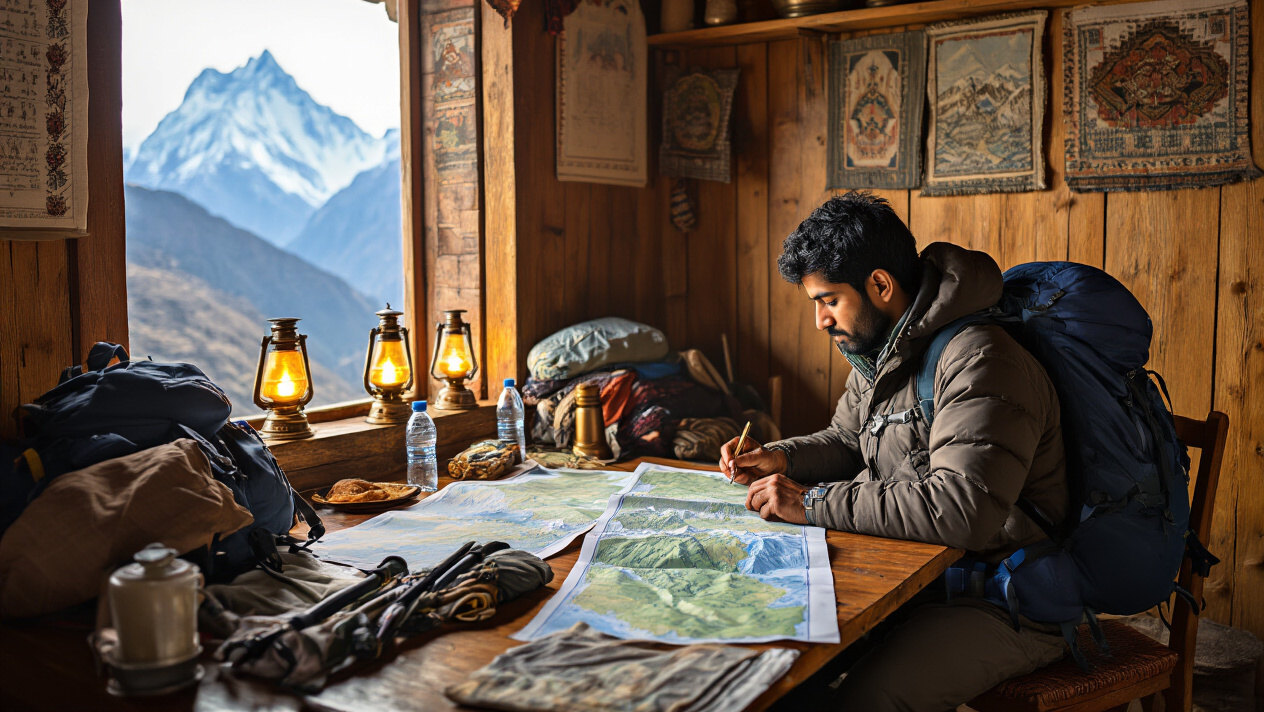
Physical Fitness Requirements and Training Recommendations
We recommend starting your fitness preparation at least 8-12 weeks before your trek departure. Our experience shows that group trekking success depends heavily on each member's physical readiness, which directly impacts the entire team's morale and pace.
Cardiovascular endurance forms the foundation of trek preparation. We suggest incorporating 45-60 minutes of cardio activities 4-5 times weekly. Running, cycling, swimming, or brisk walking all build the stamina needed for long trekking days. Stair climbing particularly mimics the uphill challenges you'll face on mountain trails.
Strength training shouldn't be overlooked. We focus on exercises that target your legs, core, and back muscles. Squats, lunges, step-ups, and calf raises prepare your legs for steep ascents and descents. Planks and back extensions support your spine when carrying a daypack for 6-8 hours daily.
Practice hikes prove invaluable in our preparation protocol. We organize local hiking sessions where group members can test their gear, build camaraderie, and assess their fitness levels together. These practice sessions help identify potential issues before reaching Nepal's remote mountains.
Weight management plays a crucial role. We advise maintaining a healthy BMI and gradually increasing your hiking distances while carrying a weighted pack. Start with 5-7 kg and progressively add weight until you're comfortable with your expected trekking load.
Gear Selection and Packing Strategies for Group Coordination
We've developed a comprehensive gear coordination system that prevents common group trekking mishaps. Our approach emphasizes standardization while respecting individual preferences and needs.
Layering system coordination ensures everyone understands the clothing strategy. We provide detailed packing lists that include base layers, insulation layers, and outer shells. Group members often share similar brands and specifications, making gear recommendations and emergency sharing more effective.
Footwear compatibility matters more than many realize. We recommend that all group members wear well-broken-in trekking boots with similar sole patterns and ankle support levels. This coordination helps maintain consistent group pace and prevents delays caused by footwear issues.
|
Essential Group Gear Categories |
Individual Items |
Shared Group Items |
|
Navigation & Safety |
Headlamp, whistle |
GPS device, first aid kit |
|
Clothing |
Personal layers, rain gear |
Emergency shelter |
|
Accessories |
Water bottles, sunglasses |
Water purification tablets |
|
Electronics |
Camera, phone |
Satellite communicator |
Packing weight distribution requires careful planning. We establish weight limits for personal items and coordinate shared gear distribution among stronger group members. Our typical allocation assigns 12-15 kg maximum personal weight, with community items distributed based on individual carrying capacity.
Gear compatibility checks happen during our pre-trek meetings. We verify that sleeping bags are rated for expected temperatures, that rain gear meets mountain standards, and that personal medical supplies complement our group first aid resources.
Acclimatization Schedules and Altitude Sickness Prevention
We structure our acclimatization protocols around proven "climb high, sleep low" principles that protect every group member while maintaining reasonable trek timelines.
Gradual altitude progression forms our core strategy. We never ascend more than 500 meters in sleeping elevation per day above 3,000 meters. Our itineraries include mandatory rest days at key elevations: typically at 3,500m, 4,200m, and before any summit attempts above 5,000 meters.
Group monitoring systems ensure no member's symptoms go unnoticed. We train all participants to recognize early altitude sickness signs: headaches, nausea, fatigue, and sleep disturbances. Our buddy system pairs trekkers for daily health checks and symptom reporting.
Hydration and nutrition coordination supports group acclimatization success. We maintain group hydration schedules requiring 3-4 liters of fluid daily at altitude. Our meal planning emphasizes high-carbohydrate foods that support oxygen utilization and energy maintenance.
Emergency descent protocols are established before reaching altitude. We identify evacuation routes, establish communication procedures, and ensure all group members understand when descent becomes necessary. Our rule prioritizes safety over summit goals - if one member needs to descend, the group structure adapts to support them.
Medication preparation includes both preventive and emergency supplies. We coordinate diamox prescriptions for members prone to altitude issues and maintain group supplies of basic altitude sickness medications. Our pre-trek medical consultations ensure everyone understands proper usage and potential side effects.
What to Expect from Premium Group Trek Packages
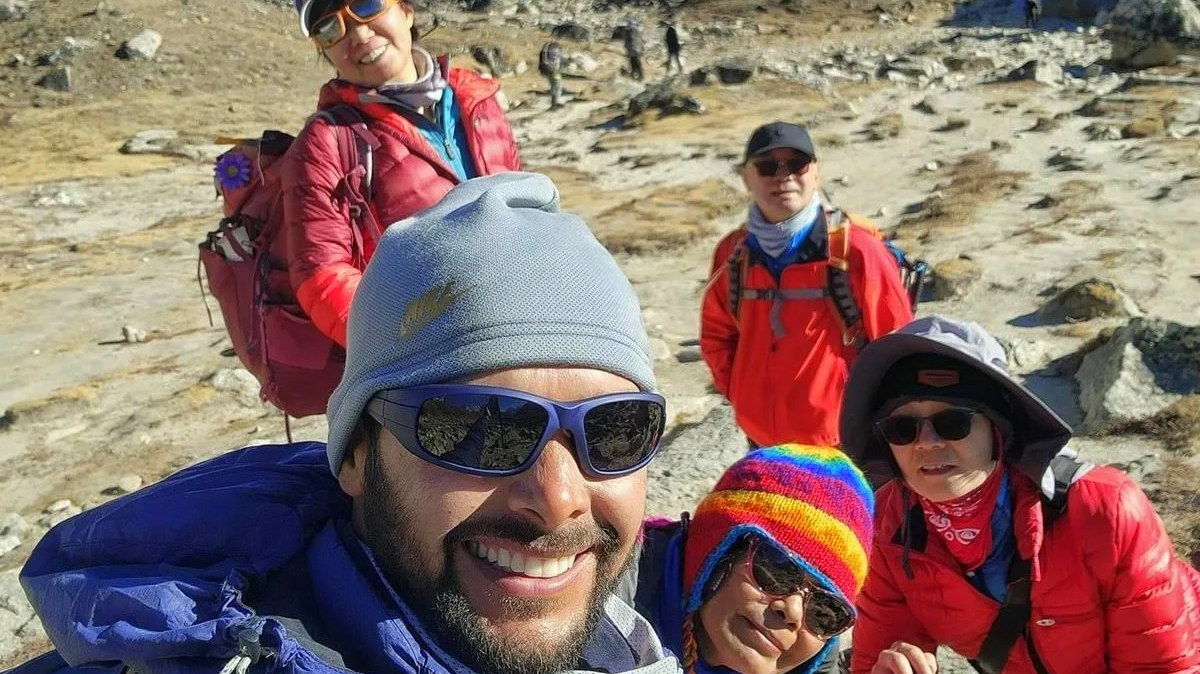
Professional multilingual guides and experienced porters
When you join our premium group treks, we pair you with certified guides who speak multiple languages fluently. Our lead guides hold government licenses and bring years of experience navigating Nepal's mountain trails. They know the terrain like the back of their hand and can share fascinating stories about local culture, wildlife, and mountain lore along the way.
We handpick our porter teams based on their strength, reliability, and positive attitudes. These aren't just carriers – they're skilled mountain professionals who ensure your gear stays safe and dry throughout the journey. Our porters receive fair wages and proper equipment, which means they're motivated to provide excellent service while maintaining ethical employment standards.
Each guide receives ongoing training in first aid, altitude sickness recognition, and emergency response procedures. They carry communication devices and know evacuation routes for every trek we operate. We maintain a 1:8 guide-to-trekker ratio on most routes, ensuring personalized attention and safety monitoring for every group member.
Comfortable tea house accommodations and meal arrangements
We've carefully selected tea house partners throughout Nepal's major trekking routes based on cleanliness, comfort, and hospitality standards. Our accommodations feature clean bedding, reliable dining areas, and basic amenities that make your mountain experience enjoyable rather than just survivable.
Your meals include hearty breakfast options like pancakes, eggs, and porridge to fuel morning hikes. Lunch typically features local specialties and international dishes prepared fresh at mountain lodges. Dinner brings variety with dal bhat (traditional Nepali meal), pasta, soups, and other satisfying options that help you recover after long trekking days.
We coordinate meal times with lodge owners in advance, which means no waiting around hungry while other groups get served first. Our guides communicate dietary restrictions and preferences ahead of arrival, ensuring vegetarian, vegan, and special dietary needs are met consistently throughout your trek.
Comprehensive permits and paperwork handling
We handle all the bureaucratic headaches so you can focus on preparing for your adventure. Our team obtains TIMS cards (Trekkers Information Management System), national park permits, and any special area permits required for your chosen route. We know which documents you need for each destination and submit applications well before departure dates.
Our office staff maintains relationships with permit offices in Kathmandu and Pokhara, which means we can navigate any last-minute changes or requirements that might pop up. We keep copies of all permits and distribute them to guides, so there's no risk of losing important documents on the trail.
For restricted areas like Upper Mustang or Manaslu, we coordinate special permits that require additional documentation and fees. We walk you through exactly what's needed and handle submission processes that can be confusing for independent trekkers.
Emergency evacuation insurance and medical support
Every premium package includes comprehensive evacuation coverage that activates the moment you experience a medical emergency on the trail. We partner with helicopter rescue services that operate throughout Nepal's mountain regions, ensuring quick response times when altitude sickness or injuries require immediate attention.
Our guides carry satellite communication devices and medical kits stocked with altitude sickness medications, pain relievers, and basic first aid supplies. They're trained to recognize early signs of altitude-related problems and make evacuation decisions before situations become life-threatening.
We coordinate directly with insurance providers and rescue services, which means you won't deal with complicated claim processes while facing a medical emergency. Our Kathmandu office maintains 24/7 contact with trekking groups and can mobilize rescue operations within hours of receiving distress calls.
The evacuation coverage extends to helicopter flights from remote locations to Kathmandu hospitals, plus medical repatriation to your home country if needed. We recommend additional travel insurance for non-emergency medical needs, but our emergency coverage handles the most serious situations that can arise during high-altitude trekking.
Best Times to Join Group Treks in Nepal

Pre-monsoon season advantages and weather conditions
March through May offers our favorite window for group trekking adventures across Nepal's diverse landscape. During these months, we experience the most stable weather patterns with crisp, clear mornings that gradually warm throughout the day. The rhododendrons paint the mountainsides in vibrant reds and pinks, creating a spectacular backdrop for our photography sessions.
Our groups particularly appreciate the comfortable daytime temperatures that hover between 15-20°C at moderate altitudes, making it perfect for steady walking without the exhaustion that comes with extreme heat or cold. The nights remain cool but manageable, typically ranging from 5-10°C in popular trekking zones like Annapurna and Everest regions.
We consistently observe excellent mountain visibility during this period, with the Himalayas standing majestically against azure skies. This season provides our trekkers with the best chances of capturing those iconic sunrise shots over peaks like Machapuchare and Everest. The dry conditions mean well-maintained trails, reducing the risk of landslides that can disrupt trekking schedules.
|
Month |
Temperature Range |
Visibility |
Trail Conditions |
|
March |
10-18°C |
Excellent |
Dry and stable |
|
April |
12-20°C |
Outstanding |
Perfect |
|
May |
15-22°C |
Very good |
Dusty but clear |
Post-monsoon clarity and festival celebrations
October through December brings exceptional clarity to the mountain views, making this period our most recommended time for groups seeking pristine Himalayan vistas. After the monsoon rains wash away dust and pollution, we witness crystal-clear atmospheres that reveal distant peaks with remarkable detail.
We love scheduling group treks during this season because our trekkers get to experience Nepal's rich cultural festivities alongside their mountain adventure. Dashain and Tihar festivals fall during October-November, allowing our groups to witness local celebrations in mountain villages. The warmth and hospitality of the Sherpa and Gurung communities shine brightest during these celebrations, creating memorable cultural exchanges for our trekkers.
The weather remains stable and predictable during these months. Daytime temperatures stay comfortable for walking, while the nights become progressively cooler as winter approaches. We find this cooling trend actually works in our favor, as it eliminates the intense heat that can make afternoon trekking challenging.
Our groups consistently report this season offers the best combination of weather, visibility, and cultural immersion. The trails remain dry and well-defined, teahouses operate at full capacity, and the overall trekking infrastructure functions optimally during these peak months.
Winter trekking opportunities for experienced groups
December through February presents unique opportunities for our more adventurous and experienced trekking groups. While many consider this an off-season, we've discovered it offers some of Nepal's most rewarding trekking experiences for properly prepared teams.
We recommend winter group treks primarily for lower altitude routes like Ghorepani Poon Hill, Langtang Valley, and certain sections of the Annapurna Circuit. These destinations remain accessible and safe during winter months while providing spectacular snow-capped mountain views against brilliantly blue skies.
Our winter groups enjoy several distinct advantages: fewer crowds on popular trails, more intimate interactions with local communities, and often reduced accommodation costs. The crisp, dry air creates phenomenal visibility conditions, allowing for stunning photography opportunities that capture the raw beauty of Nepal's winter landscape.
However, we ensure our winter groups come prepared for challenging conditions. Temperatures can drop to -15°C or lower at higher elevations, and snow can block certain high passes. We provide comprehensive gear lists and work closely with experienced guides who understand winter mountain conditions.
The key to successful winter group trekking lies in flexibility and proper preparation. We design itineraries with buffer days and alternative routes, ensuring our groups can adapt to changing weather conditions while still experiencing the magic of Nepal's winter wonderland.
Group Trek Difficulty Levels and Duration Options
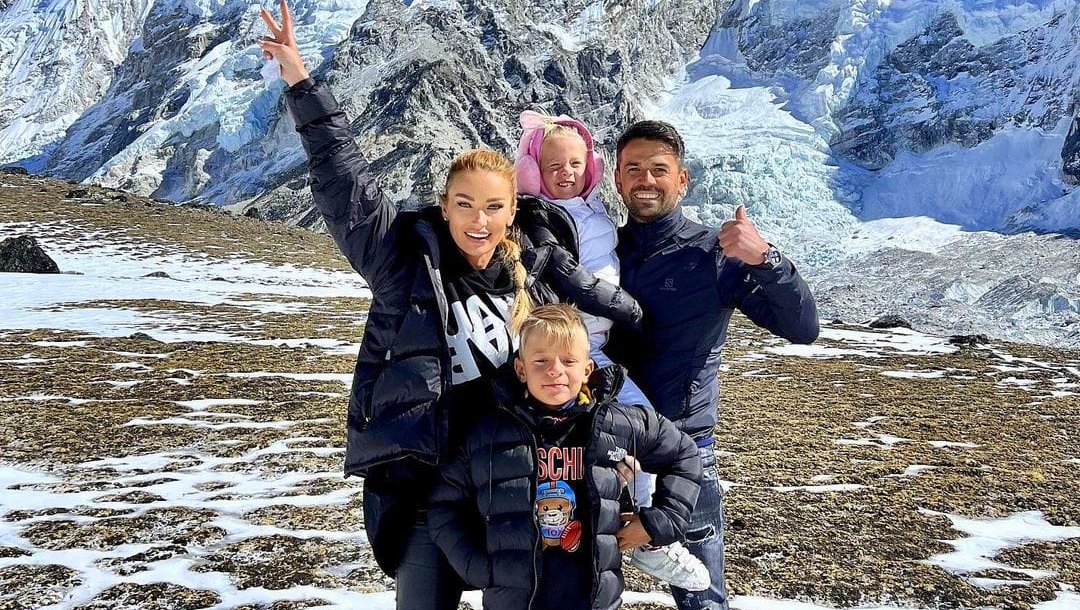
Beginner-friendly short treks for first-time visitors
We've designed our beginner-friendly treks specifically for those taking their first steps into Nepal's magnificent mountain world. Our most popular starter trek, the Ghorepani Poon Hill journey, spans just 3-5 days and offers breathtaking sunrise views over the Annapurna range without requiring technical climbing skills. The maximum altitude reaches only 3,210 meters, making it perfect for acclimatization.
Our Sarangkot trek near Pokhara provides another excellent introduction, featuring well-maintained trails and comfortable teahouse accommodations. We ensure these shorter adventures include experienced guides who understand the needs of first-time trekkers, offering constant support and cultural insights along the way.
The Nagarkot to Changunarayan trek showcases Nepal's rich heritage alongside stunning Himalayan panoramas, requiring only 2-3 days of moderate walking. We've carefully selected these routes to build confidence while delivering unforgettable mountain experiences.
Moderate difficulty multi-week adventures
Our moderate-level expeditions strike the perfect balance between challenge and accessibility, typically lasting 10-16 days. The classic Annapurna Circuit remains our flagship offering, taking groups through diverse landscapes from subtropical forests to high alpine meadows at 5,416 meters.
We organize the Everest Base Camp trek as a life-changing 14-day journey that tests endurance while remaining achievable for reasonably fit adventurers. Our groups tackle daily walking distances of 5-8 hours, with carefully planned rest days for proper acclimatization.
The Langtang Valley trek offers cultural immersion alongside mountain splendor, featuring visits to traditional Tamang villages and yak cheese factories. We've structured these adventures to include challenging sections that push personal limits while maintaining safety margins that make success attainable for dedicated trekkers.
Challenging high-altitude expeditions for seasoned trekkers
Our advanced expeditions cater to experienced mountaineers seeking serious challenges in Nepal's most remote regions. The Three Passes trek combines Everest Base Camp with Cho La, Renjo La, and Kongma La passes, demanding 18-21 days of technical trekking above 5,000 meters.
We lead groups through the restricted Upper Mustang region, where permits limit access and harsh conditions test even veteran trekkers. Our Manaslu Circuit expedition circles the world's eighth-highest peak, featuring river crossings, glacier traverses, and the demanding Larkya La Pass at 5,160 meters.
The Kanchenjunga Base Camp trek represents our ultimate challenge, requiring 22-25 days of remote trekking with minimal infrastructure support. We equip these expeditions with satellite communication devices and comprehensive medical kits, understanding that self-reliance becomes critical in these isolated environments.
Family-friendly group options with flexible itineraries
We've crafted specialized family packages that accommodate different ages and fitness levels within the same group. Our Kathmandu Valley rim trek allows families to experience mountain culture through easy day hikes from comfortable lodge bases, with vehicle support always available.
The Bandipur to Gorkha trek offers historical exploration combined with gentle mountain walking, perfect for families with teenagers interested in Nepal's royal heritage. We provide flexible scheduling that allows rest days when younger participants need breaks or alternative activities.
Our family Annapurna foothills journey features shorter daily distances (2-4 hours walking) with engaging cultural activities like pottery workshops and traditional cooking classes. We arrange separate porter support for children's gear and maintain constant communication with parents about daily progress and any necessary itinerary adjustments.
Group trekking in Nepal offers an incredible way to experience the Himalayas while building lasting connections with fellow adventurers. We've covered why joining a group can enhance your mountain experience through shared costs, increased safety, and the joy of conquering challenging trails together. From the iconic Everest Base Camp to the stunning Annapurna Circuit, Nepal's premier trekking destinations provide something for every skill level and timeline.
Planning ahead makes all the difference in your group trekking success. We recommend booking during the optimal seasons of spring and autumn, choosing a difficulty level that matches your fitness, and preparing both physically and mentally for the journey ahead. Premium group packages take care of the logistics, letting you focus on what matters most – soaking in the breathtaking mountain views and creating memories that will last a lifetime. Your Himalayan adventure awaits, and there's never been a better time to take that first step toward the mountains.
If you need any further information, please contact us by email: at [email protected], Phone: at +977- 985 100 5129 (WhatsApp).
#Tags
Tripadvisor
5.0910 reviewsGoogle
4.8110 reviewsFacebook
4.1 recommend44 ReviewsTrustpilot
4.1 Great(5 reviews)- Trusted by50K plus traveller




